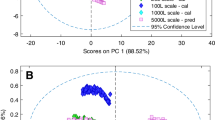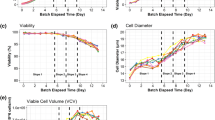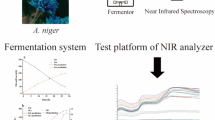Abstract
The present work focused on inline Raman spectroscopy monitoring of SARS-CoV-2 VLP production using two culture media by fitting chemometric models for biochemical parameters (viable cell density, cell viability, glucose, lactate, glutamine, glutamate, ammonium, and viral titer). For that purpose, linear, partial least square (PLS), and nonlinear approaches, artificial neural network (ANN), were used as correlation techniques to build the models for each variable. ANN approach resulted in better fitting for most parameters, except for viable cell density and glucose, whose PLS presented more suitable models. Both were statistically similar for ammonium. The mean absolute error of the best models, within the quantified value range for viable cell density (375,000–1,287,500 cell/mL), cell viability (29.76–100.00%), glucose (8.700–10.500 g/), lactate (0.019–0.400 g/L), glutamine (0.925–1.520 g/L), glutamate (0.552–1.610 g/L), viral titer (no virus quantified-7.505 log10 PFU/mL) and ammonium (0.0074–0.0478 g/L) were, respectively, 41,533 ± 45,273 cell/mL (PLS), 1.63 ± 1.54% (ANN), 0.058 ± 0.065 g/L (PLS), 0.007 ± 0.007 g/L (ANN), 0.007 ± 0.006 g/L (ANN), 0.006 ± 0.006 g/L (ANN), 0.211 ± 0.221 log10 PFU/mL (ANN), and 0.0026 ± 0.0026 g/L (PLS) or 0.0027 ± 0.0034 g/L (ANN). The correlation accuracy, errors, and best models obtained are in accord with studies, both online and offline approaches while using the same insect cell/baculovirus expression system or different cell host. Besides, the biochemical tracking throughout bioreactor runs using the models showed suitable profiles, even using two different culture media.













Similar content being viewed by others
Data availability
The datasets generated or analyzed during the current study are available from the corresponding author on request.
References
Kushwaha ND, Mohan J, Kushwaha B et al (2023) A comprehensive review on the global efforts on vaccines and repurposed drugs for combating COVID-19. Eur J Med Chem 260:115719. https://doi.org/10.1016/j.ejmech.2023.115719
World Health Organization (WHO) (2024) WHO COVID-19 dashboard. https://data.who.int/dashboards/covid19/data. Accessed 18 May 2024
World Health Organization (WHO) (2023) COVID-19 vaccine tracker and landscape. https://www.who.int/publications/m/item/draft-landscape-of-covid-19-candidate-vaccines. Accessed 9 Mar 2024
Mahboob T, Ismail AA, Shah MR et al (2023) Development of SARS-CoV-2 vaccine: challenges and prospects. Diseases 11:64. https://doi.org/10.3390/diseases11020064
Sadeghalvad M, Mansourabadi AH, Noori M et al (2023) Recent developments in SARS-CoV-2 vaccines: a systematic review of the current studies. Rev Med Virol. https://doi.org/10.1002/rmv.2359
Priyanka AMAH, Chopra H et al (2023) Nanovaccines: a game changing approach in the fight against infectious diseases. Biomed Pharmacother 167:115597. https://doi.org/10.1016/j.biopha.2023.115597
Puente-Massaguer E, Gòdia F, Lecina M (2020) Development of a non-viral platform for rapid virus-like particle production in Sf9 cells. J Biotechnol 322:43–53. https://doi.org/10.1016/j.jbiotec.2020.07.009
Liu F, Wu X, Li L et al (2013) Use of baculovirus expression system for generation of virus-like particles: successes and challenges. Protein Expr Purif 90:104–116. https://doi.org/10.1016/j.pep.2013.05.009
Kornecki M, Strube J (2018) Process analytical technology for advanced process control in biologics manufacturing with the aid of macroscopic kinetic modeling. Bioengineering 5:25. https://doi.org/10.3390/bioengineering5010025
Esmonde-White KA, Cuellar M, Lewis IR (2022) The role of Raman spectroscopy in biopharmaceuticals from development to manufacturing. Anal Bioanal Chem 414:969–991. https://doi.org/10.1007/s00216-021-03727-4
Buckley K, Ryder AG (2017) Applications of raman spectroscopy in biopharmaceutical manufacturing: a short review. Appl Spectrosc 71:1085–1116. https://doi.org/10.1177/0003702817703270
Rafferty C, Johnson K, O’Mahony J et al (2020) Analysis of chemometric models applied to Raman spectroscopy for monitoring key metabolites of cell culture. Biotechnol Prog. https://doi.org/10.1002/btpr.2977
Dong X, Yan X, Wan Y et al (2024) Enhancing real-time cell culture monitoring: automated Raman model optimization with Taguchi method. Biotechnol Bioeng. https://doi.org/10.1002/bit.28688
Takahashi MB, Leme J, Caricati CP et al (2015) Artificial neural network associated to UV/Vis spectroscopy for monitoring bioreactions in biopharmaceutical processes. Bioprocess Biosyst Eng 38:1045–1054. https://doi.org/10.1007/s00449-014-1346-7
Hutchinson A, Seitova A (2021) Production of recombinant PRMT proteins using the baculovirus expression vector system. J Vis Exp. https://doi.org/10.3791/62510
Drugmand J-C, Schneider Y-J, Agathos SN (2012) Insect cells as factories for biomanufacturing. Biotechnol Adv 30:1140–1157. https://doi.org/10.1016/j.biotechadv.2011.09.014
Augusto EFP, Moraes AM, Piccoli RAM et al (2010) Nomenclature and guideline to express the amount of a membrane protein synthesized in animal cells in view of bioprocess optimization and production monitoring. Biologicals 38:105–112
Hernández-López J, Vargas-Albores F (2003) A microplate technique to quantify nutrients (NO2−, NO3−, NH4+ and PO43−) in seawater. Aquac Res 34:1201–1204. https://doi.org/10.1046/j.1365-2109.2003.00928.x
Hopkins RF, Esposito D (2009) A rapid method for titrating baculovirus stocks using the Sf-9 easy titer cell line. Biotechniques 47:785–788. https://doi.org/10.2144/000113238
Reed LJ, Muench H (1938) A simple method of estimating fifty per cent endpoints12. Am J Epidemiol 27:493–497. https://doi.org/10.1093/oxfordjournals.aje.a118408
Dee KU, Shuler ML (1997) Optimization of an assay for baculovirus titer and design of regimens for the synchronous infection of insect cells. Biotechnol Prog 13:14–24. https://doi.org/10.1021/bp960086t
Oliveira Guardalini LG, Aragão Tejo Dias V, Leme J et al (2023) Comparison of chemometric models using Raman spectroscopy for offline biochemical monitoring throughout the VLP-making upstream process. Biochem Eng J 198:109013. https://doi.org/10.1016/j.bej.2023.109013
Oliveira Guardalini LG, da Silva Cavalcante PE, Leme J et al (2023) Biochemical monitoring throughout all stages of rabies virus-like particles production by Raman spectroscopy using global models. J Biotechnol 363:19–31. https://doi.org/10.1016/j.jbiotec.2022.12.009
Sartorius Stedim Data Analytics AB (2020) SIMCA® 15 user guide. https://www.sartorius.com/download/544940/simca-15-user-guide-en-b-00076-sartorius-data.pdf. Accessed 7 Sep 2024
André S, Lagresle S, Hannas Z et al (2017) Mammalian cell culture monitoring using in situ spectroscopy: is your method really optimised? Biotechnol Prog 33:308–316. https://doi.org/10.1002/btpr.2430
González-Domínguez I, Puente-Massaguer E, Cervera L, Gòdia F (2020) Quality assessment of virus-like particles at single particle level: a comparative study. Viruses 12:223. https://doi.org/10.3390/v12020223
André S, Lagresle S, Da Sliva A et al (2017) Developing global regression models for metabolite concentration prediction regardless of cell line. Biotechnol Bioeng 114:2550–2559. https://doi.org/10.1002/bit.26368
Yousefi-Darani A, Paquet-Durand O, von Wrochem A et al (2022) Generic chemometric models for metabolite concentration prediction based on Raman spectra. Sensors 22:5581. https://doi.org/10.3390/s22155581
Golic M, Walsh KB (2006) Robustness of calibration models based on near infrared spectroscopy for the in-line grading of stonefruit for total soluble solids content. Anal Chim Acta 555:286–291. https://doi.org/10.1016/j.aca.2005.09.014
Power J, Greenfield PF, Nielsen L, Reid S (1992) Modelling the growth and protein production by insect cells following infection by a recombinant baculovirus in suspension culture. Cytotechnology 9:149–155. https://doi.org/10.1007/BF02521742
Acknowledgements
This work was financially supported by Merck-Brazil (Installation and temporary availability of ProCellicsTM Raman Analyzer), the São Paulo Research Foundation (FAPESP) (grants no. 20/05264-0, no. 2022/02713-3), Master’s degree scholarship no. 2021/14451-0, and scientific initiation scholarships no. 2023/14085-0, no. 2022/04711-8, University of Sao Paulo (Scientific initiation scholarship-PUB 83-1/2023) and Butantan Foundation.
Funding
This work was supported by Fundação de Amparo à Pesquisa do Estado de São Paulo, 2021/14451-0, 2023/14085-0, 2022/04711-8, 20/05264-0,2022/02713-3, Pro-Reitoria de Pesquisa,Universidade de São Paulo, PUB 83-1/2023, Fundação Butantan.
Author information
Authors and Affiliations
Contributions
F.M.D. took part in experimental tasks, biochemical quantifications, and spectral data acquisition. M.M.T. took part in chemometric modeling, data curation, and manuscript writing—review & editing. S.O.C. collaborated in experimental investigation. V.A.T.D. collaborated in chemometric modeling. L.G.O.G. collaborated in biochemical and immunochemical data acquisition. J.L. collaborated in experimental investigation, work conceptualization, and methodology. T.C.B. took part in experimental investigation and supervision. F.S.S. took part in work conceptualization and experimental investigation. E.D. took part in work conceptualization and experimental investigation. R.M.A. collaborated in work conceptualization and methodology. A.T. supported work conceptualization and manuscript reviewing. S.A.C.J. got investigation funding and collaborated with work conceptualization. E.G.F.N. led work conceptualization and methodology definition, the project management, and supported the project funding as well as manuscript reviewing and editing.
Corresponding author
Ethics declarations
Conflict of interest
The authors declare no competing interests.
Ethical approval
Not applicable.
Consent to participate
All authors have their consent to participate.
Consent for publication
All authors have their consent to publish their work.
Additional information
Publisher's Note
Springer Nature remains neutral with regard to jurisdictional claims in published maps and institutional affiliations.
Supplementary Information
Below is the link to the electronic supplementary material.
Rights and permissions
Springer Nature or its licensor (e.g. a society or other partner) holds exclusive rights to this article under a publishing agreement with the author(s) or other rightsholder(s); author self-archiving of the accepted manuscript version of this article is solely governed by the terms of such publishing agreement and applicable law.
About this article
Cite this article
Moura Dias, F., Teruya, M.M., Omae Camalhonte, S. et al. Inline Raman spectroscopy as process analytical technology for SARS-CoV-2 VLP production. Bioprocess Biosyst Eng 48, 63–84 (2025). https://doi.org/10.1007/s00449-024-03094-1
Received:
Accepted:
Published:
Issue Date:
DOI: https://doi.org/10.1007/s00449-024-03094-1




